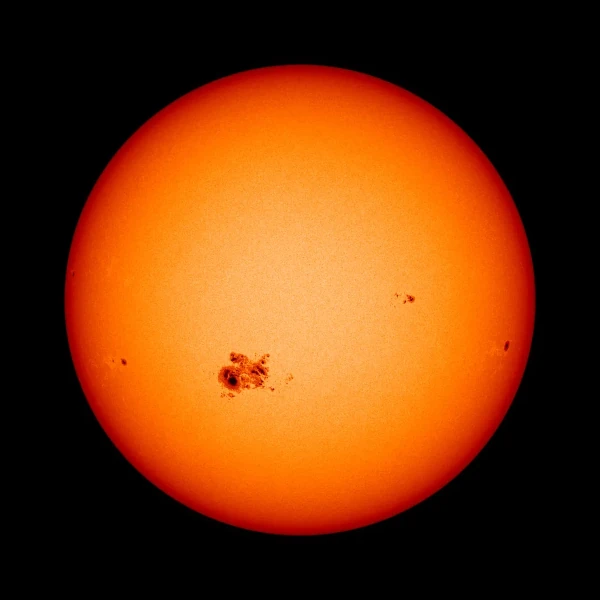
The Sun follows an approximately 11-year magnetic activity cycle, marked by variations in the number of sunspots. These spots, discovered by Galileo in 1610, appear as dark areas on the solar surface due to their lower temperature (about 3800 K compared to 5800 K for the surrounding photosphere).
Sunspots appear when intense magnetic fluxes emerge from the Sun's interior and pierce the photosphere, the visible layer of our star. These magnetic fields locally inhibit convection, reducing heat transport to the surface. As a result, the temperature in these regions drops by about 1500 K compared to the surrounding photosphere, making them visibly darker.
The mechanism behind this emergence is related to the solar dynamo, a complex process generated by the Sun's differential rotation and the turbulent movements of plasma in its convective zone. Magnetic field lines twist, tangle, and eventually reconnect or rise through the surface, forming coronal loops and sunspots.
Every 11 years or so, the Sun's magnetic field completely reverses: the north pole becomes the south pole and vice versa. This reversal marks the transition between two cycles and explains the gradual increase in solar activity toward a maximum (numerous sunspots, frequent flares, coronal mass ejections), followed by a return to the minimum (few or no sunspots, low activity).
The magnetic field density in a sunspot can reach up to \(\sim 0.3\,\text{Tesla}\), thousands of times stronger than Earth's magnetic field. These magnetic structures are often bipolar, with north and south polarities, illustrating their origin in magnetic flux tubes.
| Cycle | Period | Maximum Number of Spots | Duration (years) |
|---|---|---|---|
| Cycle 1 | 1755-1766 | 86.5 | 11.3 |
| Cycle 2 | 1766-1775 | 115.8 | 9.0 |
| Cycle 3 | 1775-1784 | 158.5 | 9.3 |
| Cycle 4 | 1784-1798 | 141.2 | 13.6 |
| Cycle 5 | 1798-1810 | 49.2 | 12.2 |
| Cycle 6 | 1810-1823 | 48.7 | 12.8 |
| Cycle 7 | 1823-1833 | 71.5 | 10.5 |
| Cycle 8 | 1833-1843 | 146.9 | 9.8 |
| Cycle 9 | 1843-1855 | 131.6 | 12.4 |
| Cycle 10 | 1855-1867 | 97.9 | 11.3 |
| Cycle 11 | 1867-1878 | 140.5 | 11.8 |
| Cycle 12 | 1878-1890 | 74.6 | 11.3 |
| Cycle 13 | 1890-1902 | 87.9 | 11.8 |
| Cycle 14 | 1902-1913 | 64.2 | 11.5 |
| Cycle 15 | 1913-1923 | 105.4 | 10.0 |
| Cycle 16 | 1923-1933 | 78.1 | 10.1 |
| Cycle 17 | 1933-1944 | 119.2 | 10.4 |
| Cycle 18 | 1944-1954 | 151.8 | 10.2 |
| Cycle 19 | 1954-1964 | 201.3 | 10.5 |
| Cycle 20 | 1964-1976 | 110.6 | 11.4 |
| Cycle 21 | 1976-1986 | 164.5 | 10.3 |
| Cycle 22 | 1986-1996 | 158.5 | 9.7 |
| Cycle 23 | 1996-2008 | 120.8 | 12.3 |
| Cycle 24 | 2008-2019 | 116.4 | 11.0 |
| Cycle 25 | 2019-2030 (predicted) | 115 (estimated) | 11 (estimated) |
Source: SILSO Sunspot Index and Long-term Solar Observations and NASA Solar Physics.